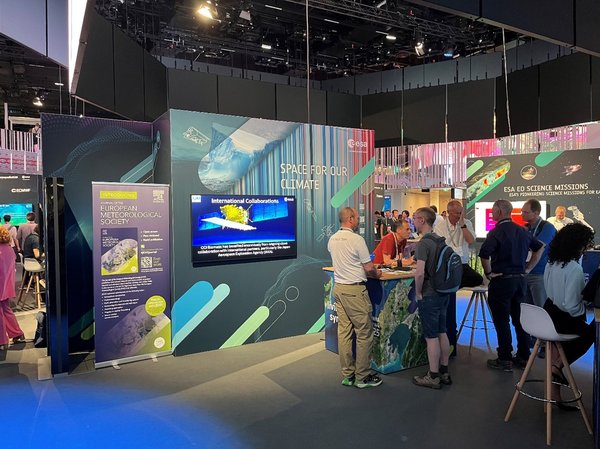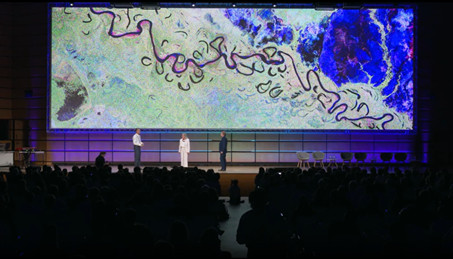The world’s largest conference dedicated to Earth Observation recently wrapped up with the value of long-term satellite climate data featuring prominently the Climate Change Initiative (CCI). The Living Planet Symposium (LPS), a conference developed by ESA, was held in Vienna from 23 – 27 June 2025. Each CCI project focuses on specific components of the climate system, collectively providing long-term climate data records for the Essential Climate Variables (ECV). The projects were represented at LPS through numerous presentations and posters.

At the opening plenary session, Simonetta Cheli, Director of the Earth Observation Programme at ESA, demonstrated the profound insights and importance of long-term datasets of Earth Observation for our understanding of the climate and its impact on the population. The glacier mass balance over the last decades, for example, revealed that “9 Gt of ice was lost between the 60s and 2020, and ESA is able to look at that with the satellites to support policy, forecasting and predictive mechanisms of ice loss.” This capability extends to tracking sea level rise, where the trend shows an increase of 3.5 to 4.8 mm per year. As Simonetta Cheli emphasised, “you see the impact this trend has, not just scientifically but also in terms of impact on areas which are lived areas, disappearance of islands and the impact on a lot of coasts.“ Beyond ice and sea level monitoring, ESA’s data provide crucial support for understanding the land use changes. The observations enable researchers to “look at droughts, at humidity of the terrain” and to monitor “the food security in terms of supporting the estimates of crop production.”
At ESA’s main booth, a central hub for discussions and knowledge exchange, CCI team members and contributing scientists demonstrated satellite data from 40+ years of different ECVs. The long-term series of data developed by the CCI provide key lines of evidence that support various states of the climate assessments, climate services, help to detect trends and by validating climate models, support prediction of future change.
Europe steps up as global climate data leader
Europe makes a major contribution to the world's climate monitoring infrastructure. While ESA Earth Explorers and Copernicus Sentinels contribute to the Global Climate Observing System (GCOS), CCI is generating a suite of climate data records addressing the ECVs. Those comprehensive datasets help us understand and assess the climate system and guide in the response to address climate change.
During the climate day on 25 June, the main plenary session, moderated by Clément Albergel (ESA) discussed the global crisis and Earth action. Dr. Helene Hewitt from the UK Met Office and member of the CMIP Panel emphasised the critical role of Earth Observation in climate projections: "Particularly in climate, future projections are so important for informing mitigation and adaptation actions. We might think that Earth Observation data is about the past, but it's also so important for informing the future." This perspective was reinforced by Prof. Martin Herold (head of the Remote Sensing and Geoinformatics section at GFZ Potsdam and co-lead of the Terrestrial Observation Panel for Climate for GCOS), who noted that understanding where and why the earth system is changing comes from "a good set of systematic Earth Observation in combination with modelling [...] without the key data we would not even understand the climate crisis."

The big advantage of Earth Observation data, such as the CCI data sets, is that every part of the globe is covered and even countries which do not have a high density of terrestrial datasets are able to understand their climate and how it is changing by using this open source data.
The CCI projects further contributed to seven Agora sessions with one key session featuring the four leading European institutes, known as the "4 Es” (the European Commission, ESA (European Space Agency), EUMETSAT (European Organisation for the Exploitation of Meteorological Satellites) and ECMWF (European Centre for Medium-Range Weather Forecasts)). This session focused on the necessity to move from climate data-collection and observation towards action. The discussion highlighted several key challenges and priorities. Dr. Mark Dowell (JRC) reflected on the need for better coordination between observations and modelling communities, stressing that robust scientific data is essential to support international reporting obligations such as those under the UNFCCC. Dr. Jörg Schulz (EUMETSAT) outlined the operational role of EUMETSAT, particularly through satellite missions such as Meteosat and EPS-SG. He also pointed out the need for sustained, high-quality data records and real-time products for climate monitoring. Dr. Rune Floberghagen from ESA underlined the importance of the Climate Change Initiative (CCI) programme, with member States recognising the value of long-term satellite data records in not only tracking and understanding the evolution of the climate, but also forming the fundamental basis for addressing and adapting the consequences of change.
Overall, the discussions at the Agora sessions underlined that we're at a critical moment where scientific information is more important than ever to guide policy decisions. Creating comprehensive climate data at every scale, e.g. for local community planning to international climate negotiations, needs to be more in the focus of our scientific work.
First images from the Biomass mission
A highlight of the Opening Session at the LPS were the newest pictures of the latest Biomass mission. Showing the first image of the mission, Michael Fehringer, Biomass Programme Manager, ESA, states, “It looks like an optical image, but in fact it’s a novel view on our planet”.

The Biomass satellite was just recently launched end of April 2025. Only 8 weeks after its launch, the first images of the Amazon forest were shown at the event. The so-called p-band imaging of the satellite, using long wavelength around 70 cm, enables to “deeply penetrate into the canopy and to see the internal structure of the forest and all the different colours tell us how diverse system in the tropical forest is”, says Klaus Scipal, Biomass Mission Manager, ESA.
The generated data of the Biomass mission will contribute to the CCI long-term satellite data records to study the climate, carbon cycle, tipping points and many other aspects. Here you can read more about the Biomass mission in the CCI context.
Visit the CCI Open Data Portal to find an overview of accessible data.

